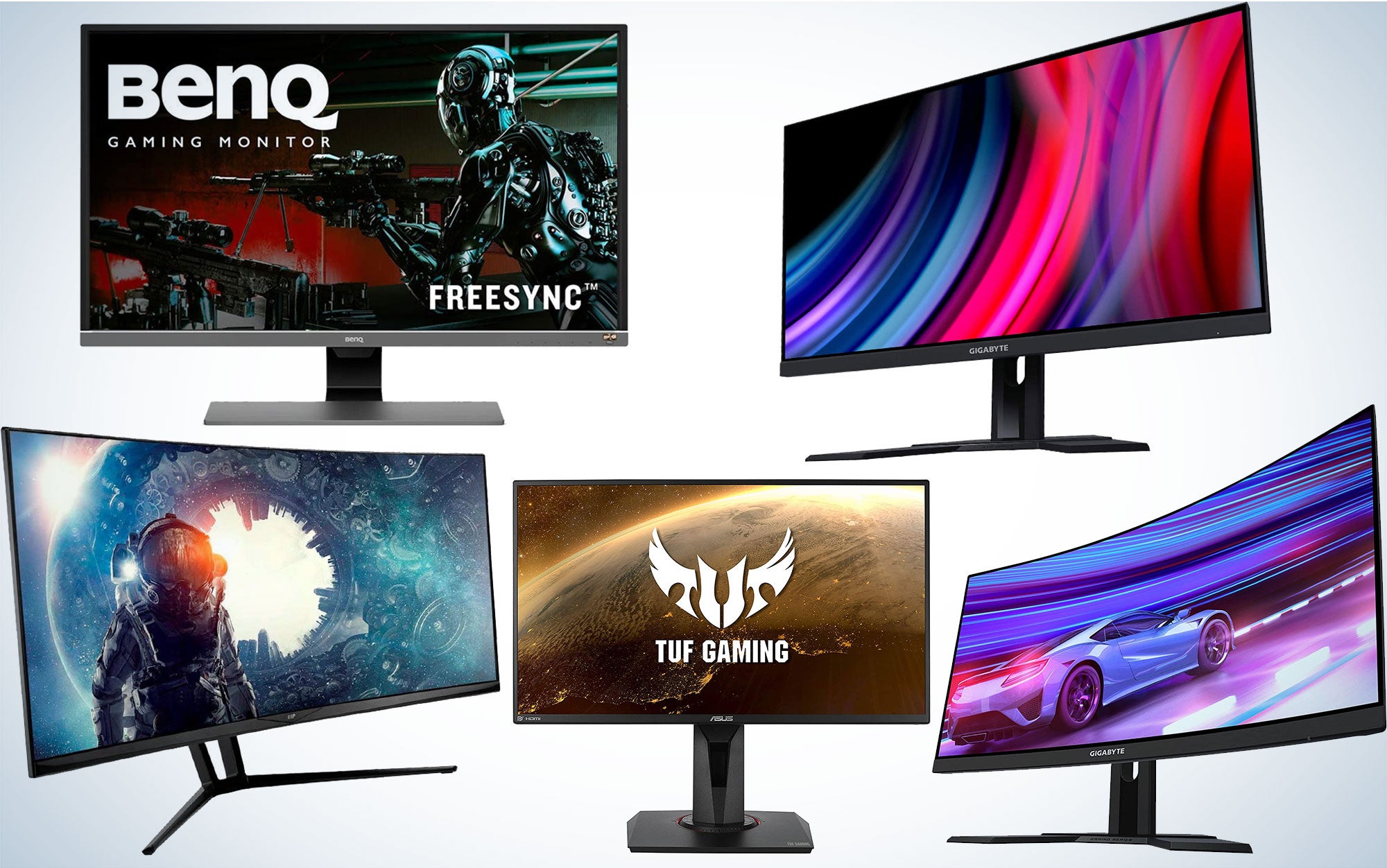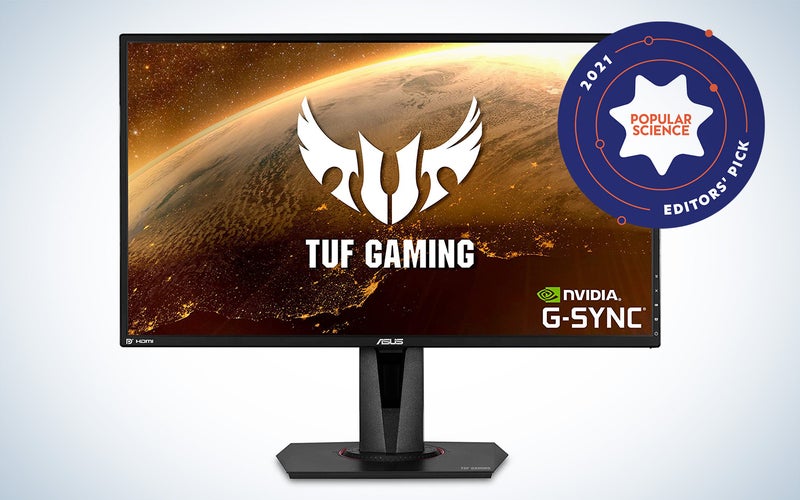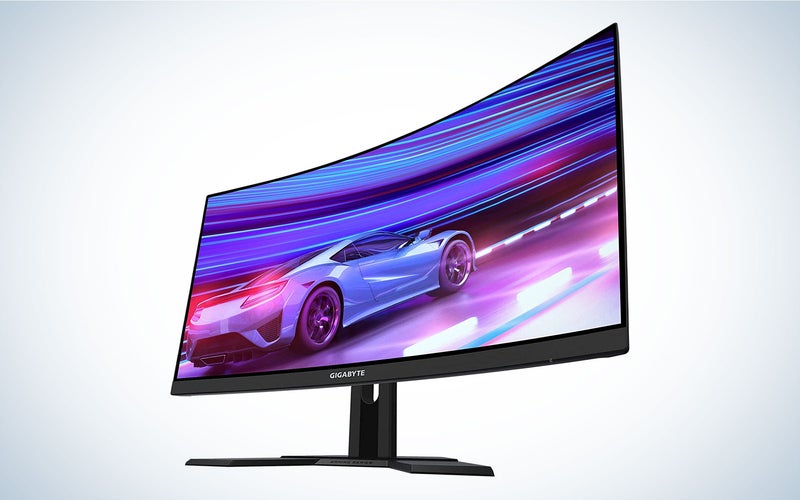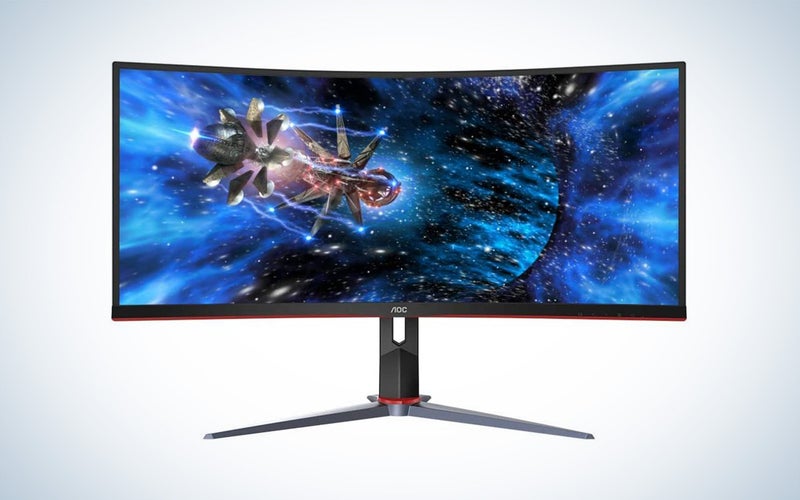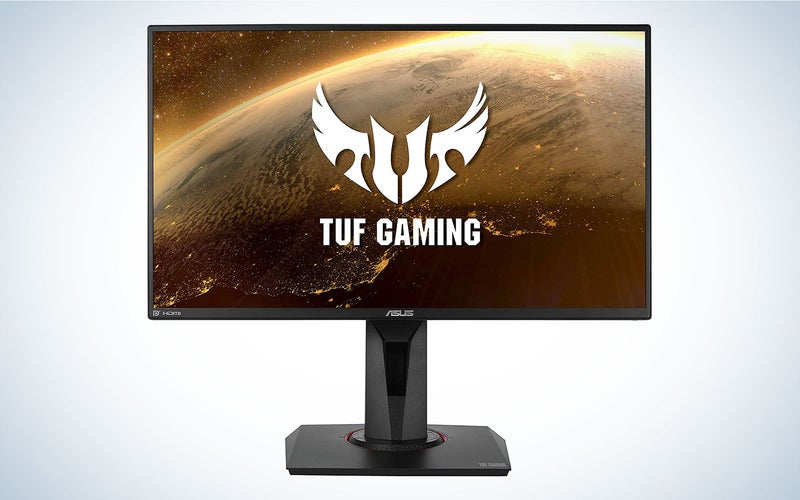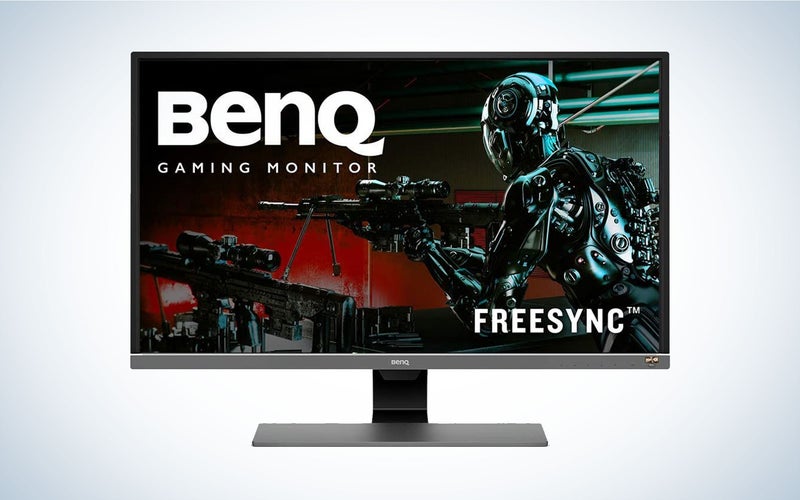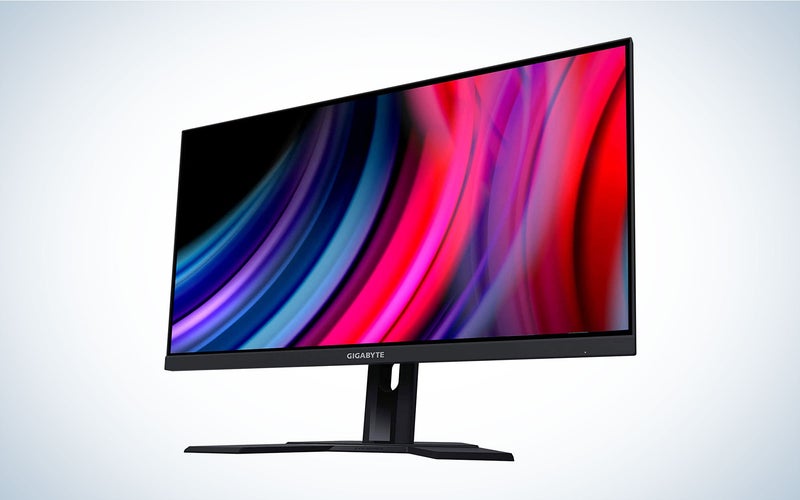We may earn revenue from the products available on this page and participate in affiliate programs. Learn more ›
Gaming monitors are kind of like cars—they become eye-wateringly expensive the moment you start caring about speed and power. You don’t need to go into debt to get a display that will run games well. Sure, you can pay $3,000 for a monitor. But if you keep your expectations in check, you can also get something that’ll do most of the work for less than $400. We’ll explain what goes into picking the best cheap gaming monitors, including key features and specs, while highlighting some of our favorites.
- Best overall: ASUS TUF Gaming 27″ 1440P HDR Gaming Monitor (VG27AQ)
- Best curved: Gigabyte 27″ Curved Gaming Monitor (G27QC)
- Best ultrawide: AOC CU34G2X 34″ Curved Frameless Immersive Gaming Monitor
- Best high-refresh: Asus TUF Gaming 24.5″ 1080p Gaming Monitor (VG259QM)
- Best 4K under $400: BenQ 32-inch 4K Monitor (EW3270U)
- Best for PS5/Xbox: Gigabyte 27” 1440p gaming monitor (M27Q)
How we picked the best cheap gaming monitors
The gaming monitor space is flush with solid options, and picking between them can feel like splitting hairs once you narrow down what you want. I’ve been covering both display and graphics card technology for about five years, in addition to building PCs and staying abreast of display technology on my own time. I’ve owned a half-dozen graphics cards and monitors from different manufacturers in that time, each one exhaustively researched before purchase.
To choose our recommendations, we combined technical reviews from multiple sites with our own knowledge of display technology and the current state of the market. In each category, we looked for the sweet spot between key gaming features and specs, with an affordable price for the product. Each of our cheap monitor recommendations costs less than $400, a common dividing line between simple gaming monitors and more feature-rich models.
The best cheap gaming monitors: Reviews & Recommendations
Now that you know the ropes, these are our picks for the best cheap gaming monitors you can get right now. While monitors often feature similar specs, each of these displays has some unique qualities that make it especially well-suited to a certain kind of gaming setup.
Best overall: ASUS TUF Gaming 27-inch 1440P HDR Gaming Monitor (VG27AQ)
Asus
Why it made the cut: A 1440p display with a variable 165Hz refresh rate and screen adjustment options? For less than $400? That’s a killer deal.
Specs
- Panel type: IPS
- Native resolution: 2560 x 1440
- Refresh rate: 165Hz
- Response time: 1ms
- Max brightness: 350 nits
- Ports: 1 x DisplayPort 1.2; 2 x HDMI 2.0
- Ergonomics: Tilt, Height, Swivel, VESA 100mm mountable
- Variable refresh rate: G-Sync Compatible/FreeSync
- HDR: HDR10
Pros
- 1440p resolution
- 165Hz with G-Sync and FreeSync compatibility
- Height, tilt and swivel adjustments
Cons
- Weak HDR
The Asus TUF Gaming 27-inch VG27AQ display has just about everything you could want from a low-to-mid-range gaming monitor making it our pick for the best cheap gaming overall. It supports a 165Hz refresh rate, compatibility with both major adaptive sync technologies, a good loadout of ports and, perhaps most remarkably, a full suite of adjustment options that include height, tilt, and swivel. It also supports HDR, which is great, but it lacks the brightness to really make the feature pop. Still, this is a robust offering from Asus, a reliable manufacturer, so this is as close to the complete package as you’ll see in this price range.
Best curved: Gigabyte 27-inch Curved Gaming Monitor (G27QC A)
Why it made the cut: Curved displays are an acquired taste, but the Gigabyte G27QC A has many great qualities for the best curved gaming monitor on a budget.
Specs
- Panel type: VA
- Native resolution: 2560 x 1440
- Refresh rate: 165Hz
- Response time: 1 ms
- Max brightness: 250 nits
- Ports: 1 x DisplayPort 1.2; 2 x HDMI 2.0; 2 x USB 3.0
- Ergonomics: Tilt & height, VESA 100mm mountable
- Variable refresh rate: Freesync, G-Sync Compatible
- HDR: HDR10
Pros
- Great contrast thanks to the VA panel
- Strong refresh rate and response time
- Lots of ports
Cons
- Limited ergonomics
- Not very bright
Gigabyte’s gaming monitors are popping up on more and more monitor buying lists, and for good reason. The G27QC A features a 1500R curvature on a VA panel that handles reflection better than many other curved displays. Meanwhile, it offers a robust feature set that includes a fast refresh rate, variable refresh rate options, and a couple of USB ports. It’s a strong package for any curved display fan.
Best ultrawide: AOC CU34G2X 34″ Curved Frameless Immersive Gaming Monitor
AOC
Why it made the cut: Ultrawide monitors usually aren’t cheap, but this AOC display will give you a chance to experience the magic for a reasonable price.
Specs
- Panel type: VA
- Native resolution: 3440 x 1440
- Refresh rate: 144Hz
- Response time: 1ms
- Max brightness: 300 nits
- Ports: 2 x DisplayPort 1.2; 2 x HDMI 2.0
- Ergonomics: Up and down, VESA 75mm mountable
- Variable refresh rate: Adaptive-Sync
- HDR: No
Pros
- Inexpensive compared to most ultrawide displays
- Curved is a good fit for Ultra-wide
- VA Panel offers great contrast
- Fast response time
- Fast refresh rate
Cons
- Barebones–No USB, no HDR
Ultrawide monitors offer lots of extra screen space, but that typically comes at a much higher cost. This curved AOC model, however, checks in well under $400 and offers some very solid specs for gamers. You won’t get the top tier stuff like HDR or HDMI 2.1. But, it does provide a solid 3,440 x 1,440 resolution and a 144Hz refresh rate. It supports Adaptive-Sync for variable refresh rates. And its response rate is just 1ms, which is quicker than most budget gaming monitors in its class. Our previous pick in this category checked in at a chunky 8ms.
If you want to do some creative work between gaming sessions, this display supports more than 100 percent of the sRGB color space and 98 percent of the Adobe RGB color space. The mounting system isn’t the most flexible we’ve ever seen, but it does allow the monitor to move up and down to match your eye line. In short, this is a ton of monitor for a very impressive price.
Best high-refresh: Asus TUF VG259 24.5-inch Gaming Monitor (VG259QM)
Why it made the cut: The Asus TUF Gaming VG259QM maxes out on frame rate, with fewer compromises than most similarly-priced monitors.
Specs
- Panel type: IPS
- Native resolution: 1920 x 1080
- Refresh rate: 144Hz, Overclock to 280Hz
- Response time: 1ms
- Max brightness: 400 nits
- Ports: 1 x DisplayPort 1.2; 2 x HDMI 2.0
- Ergonomics: Tilt, Height, Swivel, VESA 100mm mountable
- Variable refresh rate: G-Sync Compatible/Freesync
- HDR: DisplayHDR 400
Pros
- 280Hz refresh with overclock options
- Adaptive sync compatibility
- Full suite of ergonomic adjustments
Cons
- 24.5-inch display is pretty small these days
As the best cheap high-refresh gaming monitor, the Asus TUF Gaming VG259QM is the smallest monitor on this list, but it has something the others don’t. With a lightning-fast 280Hz, it is a perfect panel for players looking to maximize their competitive edge in games like League of Legends and DOTA 2. It also supports HDR, though it is only DisplayHDR 400 certified, which isn’t great. Still, this is a monitor for players who are willing to give up some visual fidelity and screen real estate for an extra microsecond against an opponent, so HDR is really just icing on the cake.
Best 4K monitor for under $400: BenQ 32-inch 4K Monitor (EW3270U)
BenQ
Why it made the cut: Doing 4K right is costly, but the BenQ EW3270U gets you pretty close for less than $400.
Specs
- Panel type: VA
- Native resolution: 3840 x 2160
- Refresh rate: 60Hz
- Response time: 1ms
- Max brightness: 300 nits
- Ports: 1 x DisplayPort 1.4; 2 x HDMI 2.0; 1 x USB Type-C
- Ergonomics: None; VESA 100 mountable
- Variable Refresh Rate: FreeSync/G-Sync Compatible
- HDR: HDR10
Pros
- Great color coverage
- Less expensive than competitors
- USB-C port
Cons
- No ergonomic options
As with ultrawide gaming monitors, your options for the best 4K gaming monitors are extremely limited if you’re trying to keep your budget down. The 32-inch BenQ EW3270U, one of the few 4K monitors available at this price point, maxes out at a merely acceptable 60Hz and 300 nits. On the plus side, it’s a big screen, offers great color reproduction, and has a USB-C port, none of which are common features on a budget monitor.
The bottom line: You have to compromise a lot for a 4K monitor if you can’t spend upwards of $500. You’re probably better off going with something lower-res, but you won’t have a bad time, either.
Best for PS5/Xbox: Gigabyte 27-inch gaming monitor (M27Q)
Why it made the cut: Getting the most out of a PlayStation 5 or Xbox Series X requires a powerful monitor, but this works well and is very affordable.
Specs
- Panel type: IPS
- Native resolution: 2550 x 1440
- Refresh rate: 170Hz
- Response time: .5ms
- Max brightness: 400 nits
- Ports: 1 x DisplayPort 1.2; 2 x HDMI 2.0; 1 x USB Type-C
- Ergonomics: Height, Tilt
- Variable refresh rate: FreeSync
- HDR: DisplayHDR 400
Pros
- Multiple HDMI ports
- USB-C
- Adjustable height and tilt
Cons
- No HDMI 2.1
Traditionally, TVs are for consoles and gaming monitors are for PCs, but there’s nothing stopping us from plugging your PlayStation, Xbox, or Switch into a gaming monitor. That said, the new consoles make some pretty serious demands in terms of display technology: Ideally, you want a 4K, 120Hz display with HDR10 and an HDMI 2.1 port. Generally speaking, that’s going to cost you more than $400.
Within our chosen price point, our main requirements were having two HDMI ports, some level of HDR, and a high refresh rate. The Gigabyte M27Q doesn’t have everything we want in a console display but it gets the job done without spending extra for features you won’t use if you’re focused on console gaming making it the best cheap gaming monitor for the PS5/Xbox.
Things to consider before buying the best cheap gaming monitors
Picking out a gaming monitor can be genuinely confusing. There are thousands of monitors on the market, with hundreds of so-called gaming monitors among them. Manufacturers often use confusing metrics to make their gear sound impressive, or proprietary technologies that may or may not actually impact your day-to-day experience. Here’s a rundown of some specs and features that we consider important, especially when you’re buying a cheap gaming monitor.
Resolution and size
It turns out that picking the two most basic aspects of your monitor, its screen size and resolution, are inherently linked. Rather than treating them as two aspects to pick and choose from, you should consider them together.
When discussing size, we’re talking about the monitor’s physical dimensions—the height and width of the screen itself, measured in inches. Resolution refers to how many pixels that display shows. This is measured by the vertical and horizontal numbers of pixels, such as 1920 x 1080. As with TVs, monitor resolutions are usually referenced by their height, such as 1080p (1920 x 1080) and 1440p (2560 x 1440). The paradigm switches to the resolution width shortened for larger sizes like 4K (3840 x 2160) and 8K (7680 x 4320).
If you buy a very large monitor but have a lower resolution—such as a 43-inch display with 1080p resolution, for an extreme example—you’ll end up with a blurry image when sitting at your desk. This works for televisions, but not for monitors. However, if you buy a 27-inch monitor with a 4K resolution display, that screen is so small for that resolution that you’ll miss out on the additional detail and make your graphics card do extra work that you don’t benefit from.
Here’s an easy rule of thumb for picking your display resolution based on monitor size:
- Anything less than 27 inches—1080p is fine.
- Anything around 27-30 inches—1440p is the sweet spot.
- Anything 31 inches or more—You should be looking at 4K if possible.
That said, size is not the only factor in play when choosing a max screen resolution. Ultimately, your PC—specifically your GPU—will determine what resolution and settings you can use for each game. If you’re rocking an Nvidia GTX 1050 Ti graphics card, you won’t be playing games in 4K, even if you have a 4K monitor. Since a large display will look blurry at a lower resolution, this means your GPU also caps the size of the monitor you should buy.
The bottom line: Don’t spend extra money on monitors with specs you can’t use (unless you’re also planning to upgrade your gaming PC in the near future). Make sure to look at which model of graphics card you have and what kind of games you like to play to see if they’re a good match for the screen resolution you want.
Refresh rate
For many players, a gaming monitor’s refresh rate is just as important as its resolution. Refresh rate, measured in Hertz (Hz), refers to the number of times your monitor can draw and redraw what’s happening on your computer screen each second. Your monitor’s refresh rate, along with your gaming PC or console’s specs, determine the maximum possible frame rate at which your games will be able to run.
Depending on what kinds of games you play and your gaming PC or console’s specs, many games seek to run at 30, 60, or 120 frames per second. Many PC games also allow for an unlocked frame rate, incentivizing you to get a monitor with the highest possible refresh rate. Unlike size and resolution, there is no disincentive for purchasing a monitor with an aspirational refresh rate (other than spending more money than you need to).
Even if you’re shopping for a cheap gaming monitor, most players should look for a display with a 144Hz refresh rate, the most common option just above 120Hz. This will allow you to play most games at high frame rates, even in competitive games, where a split-second can be the difference between winning and losing. Going past around 165Hz, you’ll begin to see diminishing returns (and somewhat degraded image quality). These ultra-high refresh displays usually get their fast refresh by pushing displays into an “overdrive” mode that asks more of the pixels than intended by the panel maker. If you’re planning to use the screen just for work, 60Hz is just fine.
Variable refresh rate
Historically, monitors (and televisions) have operated at specific frequencies—the number of times per second that the image will refresh. The monitors you use at work or that came with your first computer probably run at the standard 60Hz frequency, refreshing 60 times per second.
This is great for movies and television, which have preset frame rates, but terrible for games. Game developers work to keep frame rates consistent, but they don’t always stay that way. When a game’s frame rate fluctuates, that causes your graphics card to try to pass video frames to your monitor at uneven rates. This can result in screen tearing or dropped frames. Variable Refresh Rate technology, in short, gets your monitor and graphics card in sync. Instead of the graphics card having to wait for the monitor to be ready for an image, the two talk to each other, and the monitor can refresh when an image is passed to it, making for a smoother image when gaming.
There are two proprietary variable refresh rate technologies used in most gaming monitors tied to the two major graphics card manufacturers: Nvidia G-Sync and AMD FreeSync. G-Sync is a hardware-enabled system that theoretically rewards players who pair an Nvidia GPU in your PC and a “G-Sync certified” monitor with special hardware. FreeSync, a purely software-based option, is more common, but less regulated. That said, many monitors support both FreeSync and G-Sync, even if they aren’t specifically certified.
Ultimately, a certified G-Sync monitor is a nice cherry on top for a monitor if your PC sports an Nvidia GPU, but isn’t necessary, especially in this price range. In most cases, it’s enough to look and simply note what GPU you have and buy a monitor that supports your system.
Response time
A less scrutinized spec, response time refers to how quickly the pixels in a display can change, which also affects how quickly and smoothly your games animate. Response time is trickier to track than refresh rate, as manufacturers do not adhere to a single standard for measuring it. Some measure black-to-white, some black-to-white-to-black, and yet others measure from one shade of gray to another.
Many manufacturers approximate monitor response times—they’ll say “1ms.” Due to the ways different makers judge this statistic, though, it’s always good to search for the model of monitor you’re interested in, along with the word “ghosting,” to see if other users are struggling with issues caused by poor response time, including after images and image smearing.
Panel type
There are three types of display panels: Twisted Nematic (TN), Vertical Alignment (VA), and In-Plane Switching (IPS). Each display has its strengths and weaknesses. A TN display will typically have the fastest refresh, but weaker color reproduction and viewing angles. IPS displays have the best color reproduction, but comparatively poor contrast. VA displays have the best black levels of the three types of display panels and match the wider viewing angles of IPS displays. They have slightly slower response time and color gamut compared to IPS, though still much better color than a TN panel.
While TN displays are technically the fastest, most players prefer IPS and VA panels, which can handle fast refresh rates and response times well enough, while offering a better overall picture. All of our picks feature IPS or VA panels.
Brightness, color depth, and HDR
High-dynamic range, or HDR, is a display technology that allows for more nuanced levels of brightness and color depth in a display picture. In video games, it is most frequently used to enhance visuals through better lighting, and allowing a wider range of dark spaces. (For example, HDR makes it possible to replicate that fuzzy feeling of seeing in the dark in a cave or poorly lit room).
With TVs, where the technology is more common, there are two HDR standards: HDR10 and DolbyVision. With monitors, HDR is less common and more segmented. Some monitors support HDR10. Others support various DisplayHDR levels, which refer directly to the monitor’s maximum brightness, measured in nits or cd/m². Many of our top picks technically support HDR, but don’t get bright enough to really show off the feature.
In general, we recommend players looking to prioritize HDR monitors to look for an HDR10-compatible monitor with a maximum brightness of 1000 nits or higher, or one with an official DisplayHDR 1000 rating.
FAQs
Q: Is G-Sync or FreeSync better?
If you have an Nvidia graphics card, hardware-based G-Sync typically offers the smoothest, most stable variable refresh rate. The choice gets much trickier when you’re picking between AMD FreeSync and software-based G-Sync, which you’ll find with most of the picks on this list. Both services can have some quirks and vary from monitor to monitor. Ultimately, both versions work well on any officially compatible display.
Q: Is flat or curved better?
If you’re the only person who uses your PC and you plan to rock a single-monitor setup, a curved display can create a more immersive gaming experience. It can also catch light from more angles, though. A curved monitor is somewhat of an acquired taste. It isn’t for everyone, but the people who try it and like it tend to prefer it over a standard flat panel.
Q: Are cheap 144Hz monitors worth it?
Absolutely. A 144Hz display can show up to 144 individual images per second. Despite what some people will argue on forums, the human eye can discern the difference between 30, 60, and 144 frames per second. If you play games frequently and have a moderately powerful graphics card, a 144 Hz display will allow for smoother animation and better-looking games.
Q: Is 4K resolution worth it?
Making the jump to 4K on a gaming PC can be tricky … and expensive. You need a graphics card—such as an Nvidia RTX 2080, 3070, or higher—to run games at 4K resolution. You should also be prepared to spend a good amount of money on a 4K monitor no smaller than 32 inches. If you have an otherwise mid-range system, or would prefer a smaller screen, you probably should hold off on upgrading to 4K.
Q: What about OLED panels?
Organic light-emitting diode, or OLED, displays make for gorgeous screens thanks to the technology’s ability to light individual pixels. OLED panels are more commonly used for TVs and smartphones than PC monitors, though. In addition to being expensive, they are susceptible to long-term screen burn-in, which would severely limit their lifespan.
The final word on the best cheap gaming monitors
Finding a very good monitor for less than $400 isn’t as hard as you might think. There are tons of options, so sorting through them to find the best can be tough, but there are also lots of great choices.
That said, there are also some very tight limitations on what you can and cannot get on the cheap. You’ll have to make some serious compromises to get a 4K or ultrawide monitor. Likewise, the new consoles will probably fare better on a 4K television. But if you’re interested in a 1440p monitor with a high refresh rate—often considered the current sweet spot for modern graphics cards—the world is your oyster.
